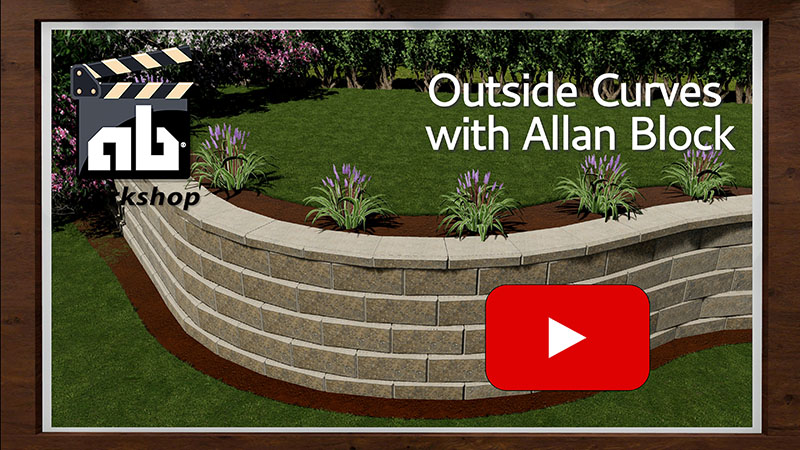Building Curves
Building curved and serpentine retaining walls is simple. Allan Block's patented design allows for easy installation of both inside and outside curves. Most curves can be built with no cutting involved.
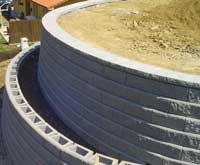
AB Collection retaining wall

Offset the vertical seams
- Try to maintain an offset of the vertical seams by at least ¼ of the block length from the courses below. Cutting a block in half or using the half width blocks, will assist in creating a proper offset.
- Before beginning construction, review the plans and layout the retaining wall to eliminate tight radii. More gentle sweeping curves produce more aesthetically pleasing retaining walls. See radius chart for more details.
- Use blocks with lower setbacks or half width blocks on curves for smoother transitions.
- To build a flowing inside curve, butt the block end to end to match the smooth curve required on the project. Try to keep spacing consistent between the backs of the blocks.
Outside Curves
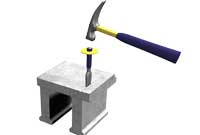
AB Fieldstone: Remove wings off blocks

AB or AB Europa: Remove wings off block
- To build smooth outside curves, remove one or both of the "wings" from the back of the blocks and tighten the radius of the curve. Break wings off by tapping on the back of the wing to obtain a clean break. For the AB Fieldstone anchoring units, use a hammer and chisel in the existing score line.
NOTE: An AB Fieldstone 812 assembly is recommended for building curved retaining walls. The 824 assembly will work in large gradual curves only.

Working with Radii
Refer to the Radius Chart to confirm that the AB product you are using will accommodate the desired wall radius.
The tightest or smallest radius at the top of any AB wall using full size block is 4 ft. (1.2 m), and 2.5 ft. (0.8 m) using the half width blocks. The final height of the wall will determine what the minimum radius at the base course must be.Curved walls have a greater setback, which causes a coning effect to occur causing your retaining wall to have its tightest radius at the top of the wall which in turn creates the need for a larger radius at the base course.
Use the radius chart to determine what the minimum recommended radius of the base course of the wall needs to be, so the top course of the wall will not be less than 4 ft. (1.2 m).
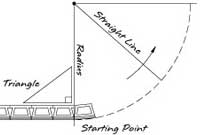
How to start a curve
Starting a Radius
From the point of where the curve will start, measure straight back from the wall the required amount (shown in the radius chart) and drive a stake into the ground. This will be the center of the curve. Attach a string line to the stake the length of the radius and rotate it around to mark the location of the base course. Install the blocks with the front of the blocks lining up with the mark.
- To transition the curve back into a straight wall or another curve, lay out the curve and the first couple blocks of the next section. Adjusting 1 or 2 of the blocks will help in the transition of the next section of the retaining wall.
For AB, AB Aztec, AB Metro & AB Europa Walls
Curves with Reinforcement
When placing geogrid along curved retaining walls, the geogrid should follow the back of the lip on the retaining wall block. Simply slit the geogrid with a utility knife and either feather out or overlap to follow the curve.
Inside Curves and Geogrid
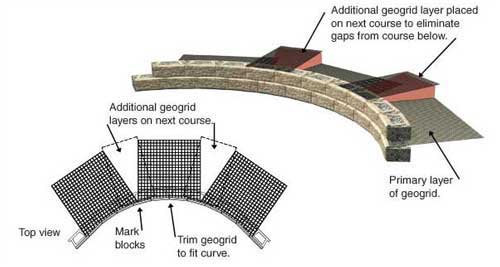
Inside Curves with Geogrid
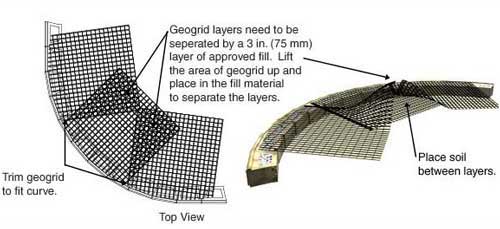
Outside Curves with Geogrid
Geogrid needs to have 100% coverage around any curve. To achieve this, additional layers need to be installed above the course where the geogrid is required to fill voids that are created.
- Cut geogrid to required lengths per the approved plan.
- Lay out the primary geogrid around the curve butting front edges together. Make sure strength direction runs perpendicular to wall face. Mark the blocks or take note of the areas where there are voids in the grid placement.
- Place the filler piece of grid on the next course (or the course below) to cover the void left on the primary layer.
Note: For taller walls over 10 ft. (3 m), starting the filler piece of grid at the back of the block may eliminate the need for shimming as the wall gets taller.
Outside Curves and Geogrid
- Cut geogrid to required lengths per the approved plans.
- Lay out the geogrid around the curve.
- Lift the section of grid that overlaps and place the fill material to separate. Grid layers need to be separated by a 3 in. (75 mm) layer of approved fill material.
- Never compact directly on the geogrid.
Building Tighter Curves
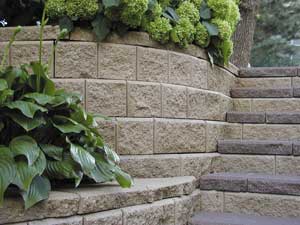
For a smooth curve with less cutting, use our half width blocks to help build the curve.
Using full size blocks in tight curves will create a gap between the courses. For cleaner lines, it may be necessary to remove parts of the bottom notch to fit the blocks closer together.

Cutting the bottom notch for tighter inside curves
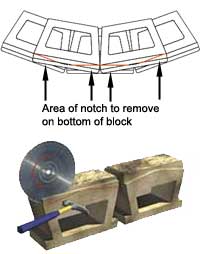
Cutting the bottom notch for tighter outside curves
Capping Curves

Place two caps on top of the wall, spaced so a third cap will fit tightly between their widest point

Mark the overlap on the bottom of the center cap

Cut cap on marks to fit between caps

Measure the distance of the gap between the 2 caps (x) at the front of the wall
If you are using AB Fieldstone, follow instructions on capping AB Fieldstone.
- Place two caps on top of the wall, spaced so a third cap will fit tightly between their widest point.
- Set another cap on top of the first two caps in the center and mark where they overlap on the bottom of the center cap.
- Remove the center cap and cut along the marks. Then set in place so the three fit tightly together.
- Repeat this process as often as needed to cap the entire curve.
- It's a good idea to secure caps with a high strength construction adhesive once they are all cut.
More options for finishing your retaining wall.
Capping Tighter Curves
If you are using AB Fieldstone, follow instructions on capping AB Fieldstone.
- For and outside radius, place two caps on top of the wall, with the back of each cap tight together. A gap will appear in the front.
- Measure the distance of the gap between the 2 caps (x) at the front of the wall.
- Measure out this distance (x/2) on the back of each of the cap and mark.
- Draw a line from the mark to the front corner.
- Use a masonry saw to cut each cap.
- The above steps work for both inside and outside radiuses.
More options for finishing your retaining wall.
For AB Fieldstone Walls
Outside Curves with AB Fieldstone

Outside Curve
On outside curves, remove one or both of the wings from the anchoring unit to for the curve desired. Use the radius chart to determine the minimum radius on the base course.
Inside Curves with AB Fieldstone

Inside Curve
On inside curves, place the facing units to form the curve. Keep the front of the blocks tight together.



